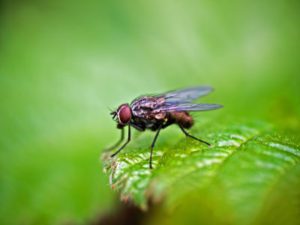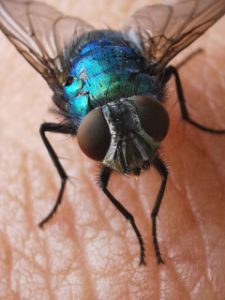IT’S TRUE! HOUSE FLIES REALLY ARE HARDER TO SWAT!
By Zachary Ciras on January 19, 2021.
Science says it really is as hard to swat a house fly as you think it is. It’s not just you. House flies have more successful escapes, all thanks to their halteres.
Entomologists (but not many other people) know that flies really have two pairs of wings. Unless you’re an expert, you could probably never find the second, less obvious, pair called halteres. These secondary hindwings have been reduced to a pair of short, knobbed structures found underneath a fly’s larger flight wings. Considering that they evolved from wings, halteres don’t seem to be very useful. They don’t generate lift and they don’t help in flight. But they do function as sensory organs and help with balance and stabilization while a fly is flying.
THERE ARE BENEFITS TO A SPEEDY EXIT – IF YOU’RE A FLY
Flies have those big, multi-faceted eyes and it seems that they can see you, or the fly swatter, approaching from any direction. They use this ability to quickly spot and escape that swatter by taking off from a still position in a fraction of a second. Now researchers at Case Western University have found that a fly’s halteres might also be helping it escape the swat.

House fly side view. Shutterstock.
House flies belong to a more sophisticated group of flies that can move these hindwings rhythmically when standing. Researcher Alexandra Yarger and her team wanted to see if this behavior affected a fly’s ability to take off. After using a high speed camera to record 20 different fly species (all with halteres), the group concluded that the house fly group was about five times faster at taking off than other flies. After they surgically removed a house fly’s halteres, both the speed and the stability of its takeoffs were reduced.
“We think there might be a pathway from halteres to the legs that’s causing them to take off faster,” says Yarger. “It doesn’t go through any central nervous system, it’s almost like a reflex.”
GOT FLIES? CONSIDER THE POSSIBILTIES
Admittedly, all of this science doesn’t help you much with fly control but now you know what you and your fly swatter are up against. Most of us in this region are not in the habit of swatting flies in our homes in the middle of the winter. If you are, you could be swatting the tiny nuisance gnats (phorid flies, drain flies, fruit flies) that can live and reproduce indoors year round.
If what you’re swatting is larger and looks like a house fly, it might be a cluster fly. The two flies look very similar and cluster flies often spend the winter in attics and voids. Cluster flies and other overwintering flies can become active indoors on warm winter days.

Blue Bottle fly, often associated with animal carrion (dead animal) when found. Shutterstock.
It’s also possible to have an ongoing infestation of flesh-feeding blow flies or house flies in a home if there is a dead rodent or other animal carcass hidden in a wall or ceiling void. It’s the maggot-like fly larvae that feed on the decaying carcass but it’s the emerging flies that are hard to overlook (see Are House Flies Breeding Inside Your Home?).
ADD COLONIAL PEST TO YOUR “SWAT TEAM”
Since house flies can breed in almost any kind of moist, decaying animal or vegetable material, finding one source of flies does not always solve your problem. See House Flies Indoors? for an idea of the many possible indoor house fly breeding sites.
When it comes to a fly infestation, professional intervention is always a good idea. Colonial Pest Control can help with all types of fly problems, year round. Give us a call!